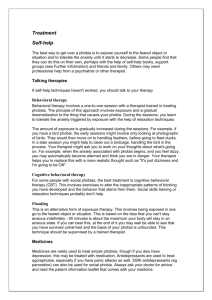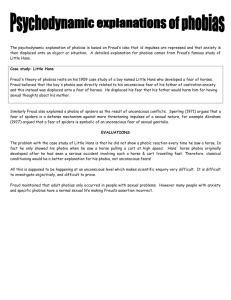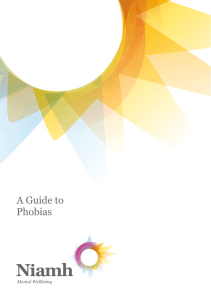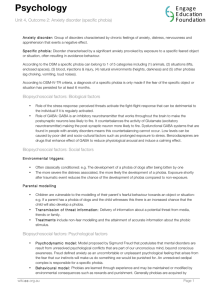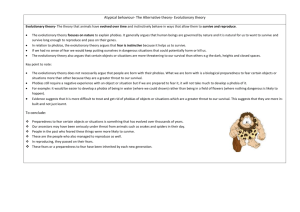Summer 2005 - Assessing Fears & Phobias
advertisement
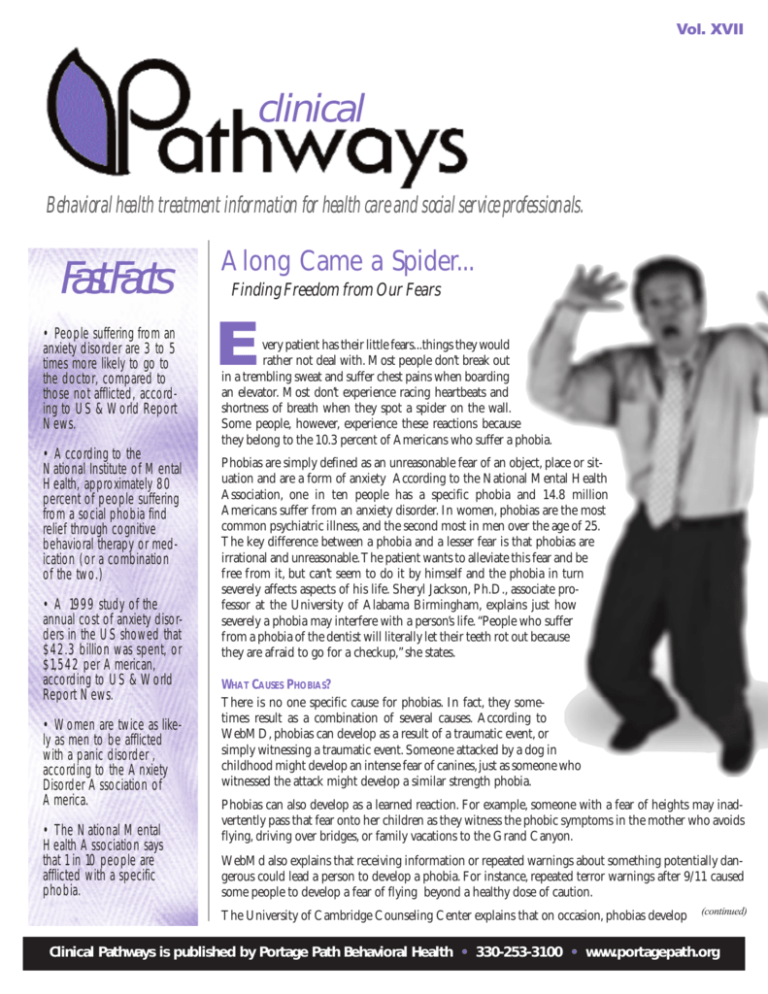
Vol. XVII clinical Behavioral health treatment information for health care and social service professionals. Fast Facts • People suffering from an anxiety disorder are 3 to 5 times more likely to go to the doctor, compared to those not afflicted, according to US & World Report News. • According to the National Institute of Mental Health, approximately 80 percent of people suffering from a social phobia find relief through cognitive behavioral therapy or medication (or a combination of the two.) • A 1999 study of the annual cost of anxiety disorders in the US showed that $42.3 billion was spent, or $1,542 per American, according to US & World Report News. • Women are twice as likely as men to be afflicted with a panic disorder , according to the Anxiety Disorder Association of America. • The National Mental Health Association says that 1 in 10 people are afflicted with a specific phobia. Along Came a Spider... Finding Freedom from Our Fears E very patient has their little fears...things they would rather not deal with. Most people don’t break out in a trembling sweat and suffer chest pains when boarding an elevator. Most don’t experience racing heartbeats and shortness of breath when they spot a spider on the wall. Some people, however, experience these reactions because they belong to the 10.3 percent of Americans who suffer a phobia. Phobias are simply defined as an unreasonable fear of an object, place or situation and are a form of anxiety According to the National Mental Health Association, one in ten people has a specific phobia and 14.8 million Americans suffer from an anxiety disorder. In women, phobias are the most common psychiatric illness, and the second most in men over the age of 25. The key difference between a phobia and a lesser fear is that phobias are irrational and unreasonable.The patient wants to alleviate this fear and be free from it, but can’t seem to do it by himself and the phobia in turn severely affects aspects of his life. Sheryl Jackson, Ph.D., associate professor at the University of Alabama Birmingham, explains just how severely a phobia may interfere with a person’s life. “People who suffer from a phobia of the dentist will literally let their teeth rot out because they are afraid to go for a checkup,” she states. WHAT CAUSES PHOBIAS? There is no one specific cause for phobias. In fact, they sometimes result as a combination of several causes. According to WebMD, phobias can develop as a result of a traumatic event, or simply witnessing a traumatic event. Someone attacked by a dog in childhood might develop an intense fear of canines, just as someone who witnessed the attack might develop a similar strength phobia. Phobias can also develop as a learned reaction. For example, someone with a fear of heights may inadvertently pass that fear onto her children as they witness the phobic symptoms in the mother who avoids flying, driving over bridges, or family vacations to the Grand Canyon. WebMd also explains that receiving information or repeated warnings about something potentially dangerous could lead a person to develop a phobia. For instance, repeated terror warnings after 9/11 caused some people to develop a fear of flying beyond a healthy dose of caution. The University of Cambridge Counseling Center explains that on occasion, phobias develop (continued) Clinical Pathways is published by Portage Path Behavioral Health • 330-253-3100 • www.portagepath.org Along Came a Spider... (continued) as a reaction to a panic attack.The patient may not understand why she had a panic attack in the first place, so she will try to explain it by examining her surroundings for clues. If there was a spider on her sleeve when she had the attack, she might conclude that she must be intensely afraid of spiders to have such an awful reaction, and thus develop arachnaphobia. A feature article on the FDA website suggests there might be a biological explanation for some phobias, social phobias in particular. Neurotransmitter receptor abnormalities in the brain are suspected to play a role in the development of this particular phobia. Psychologically and emotionally, low self esteem, poor social skills, feelings of inferiority and a general lack of assertiveness are also believed to contribute to social anxiety and social phobias. DIFFERING TYPES OF PHOBIAS To better help your patient with his or her phobia, the first step is to determine the type of phobia. They are typically broken up into three categories. The first is a simple phobia, or the fear of a specific object, place or situation, such as spiders, auditoriums, or being in an elevator. The second type of phobia is known as agoraphobia.Translated literally from Greek, it means “fear of the marketplace.” Agoraphobics are uncomfortable in open spaces, or crowded spaces where they might feel trapped or unable to get help should they have a panic attack. “A person suffering from agoraphobia will limit the places he goes so that he can feel more comfortable and eliminates the places he has had panic attacks in the past,” comments Linda Bradley, Intake Coordinator at Portage Path Behavioral Health. “The problem with this is that his environment shrinks completely until he eventually can’t leave his home.” Phobia Treatment Methods The final type of phobia is a social phobia, which is a persistent fear of being scrutinized, humiliated, or losing control in new situations or when around unfamiliar people. “People with social phobias aren’t simply shy,” Bradley warns. In fact, many sufferers of social phobia are extremely comfortable and outgoing in certain scenarios. Exposure treatment is one of the most common ways to treat a phobia, according to phobialist.com. During exposure treatment the patient is exposed to the stimulus slowly and taught to substitute relaxation techniques until the fear subsides. By using Systematic Desensitization, the patient and therapist draw a hierarchy of their fears and work towards the most fearful stimulus. For example, someone with a fear of spiders might first look at pictures of the spider, and then stand five feet away from one that is in a jar. Once that is achieved, he might hold the jar in his hand. Eventually , the patient will be able to hold the spider itself without debilitating fear. Anxiety disorders, phobias in particular, tend to vary in degree. Some are so mild that it is often hard to consider them a real disorder, while others dominate the lives of the individual who suffers from them. For example, someone who is afraid of lions merely has to avoid the zoo unless they live in the jungle. But for someone suffering from a social phobia, the effects can be crippling. WHEN PHOBIAS APPEAR As with any phobia, a social phobic experiences a racing heart, shortness of breath, chest pains, sweating and potentially a debilitating panic attack. Unfortunately, they also suffer from additional symptoms. According to the National Mental Health Association, they will view small mistakes as more exaggerated than they are, will blush often and find it painfully embarrassing, fear that all eyes are constantly on them and fear speaking in public, dating, and talking with authority figures. For some, they even fear using public restrooms or eating out and have fear of talking on the phone or simply writing in front of others. They may even suffer compulsive behaviors. Because of the severity of the symptoms, sufferers of social phobia and agoraphobia may lead impaired lives without proper help. HELP FOR PHOBICS Fortunately, treatment is available for phobias. “Clinicians use a combination of several techniques when treating individuals with phobias,” Bradley explains. “These techniques include the use of medication and behavior therapy. Training in relaxation is an important concept for behavioral therapy, as well as imagery.”The length of treatment differs greatly for each person and the severity of their phobia. “However, taking a passive role , rather than an active role in treatment, will lead to limited results,” Bradley warns. For more information on treating phobias, see Phobia Treatment Methods (below) or call Portage Path Behavioral Health at 330-253-3100. Another form of Exposure is the use of modeling. The patient observes others in the presence of the phobic stimulus who respond with relaxation instead of fear.The patient learns through watching that there really isn’t anything to fear. Another highly used method of treatment is Cognitive Behavioral Therapy, which helps the patient change the way they look at fear.The patient learns to challenge the thoughts associated with the fear, and recognize that the anxiety is normal but can’t actually harm him, according to the University of Cambridge Counseling Center. “Cognitive restructuring provides the patient with informational interventions that de-mystify the flood of bodily symptoms they experience,” explains Linda Bradley, a clinician at Portage Path. “It is designed to de-catastrophisze the beliefs about the meaning and consequences of the symptoms they experience.” Medication has also been used to control the symptoms phobias elicit. According to the Mayo Clinic, Beta Blockers work by blocking the stimulating effects of epinephrine (adrenaline.) Antidepressants reduce anxiety and sedatives help the patient relax. Top 10 Phobias Famous Phobics from US News & World Report according to www.phobia-fear-release.com & The Discovery Channel 1) ARACHNOPHOBIA - fear of spiders. Half of women and 10 percent of men have , to some degree, a fear of spiders. Patients suffering from any behavioral disorder are comforted by the knowledge that they are not alone. Below are a few celebrity phobias to share with your patient. • NAPOLEON BONAPARTE - AILUROPHOBIA , the fear of cats 2) SOCIAL PHOBIA - fear of being evaluated negatively in social situations. Approximately 5.3 million American Adults have social phobia. • QUEEN ELIZABETH I - ANTHOPHOBIA, fear of flowers (she was afraid of roses) 3) AEROPHOBIA - fear of flying. • SIGMUND FREUD - AGORAPHOBIA, fear of crowded, open spaces 4) AGORAPHOBIA - intense fear and avoidance of any place or situation where escape might be difficult or help would be unavailable in the event of developing sudden panic symptoms. Translated from Greek, it literally means “fear of the marketplace.” • EDGAR ALLEN POE , HARRY HOUDINI, ADOLF HITLER CLAUSTROPHOBIA , fear of being trapped in confined spaces • DONALD TRUMP - CHIROPHOBIA, fear of shaking hands • HOWARD HUGHES - MYSOPHOBIA, fear of germs • ANDRE AGASSI - ARACHNAPHOBIA, fear of spiders • CHER, WHOOPIE GOLDBERG, JOHN MADDEN, ARETHA FRANKLIN AEROPHOBIA, fear of flying 5) CLAUSTROPHOBIA - fear of being trapped in small , confined spaces. 6) ACROPHOBIA - fear of heights. 7) EMETOPHOBIA - fear of vomit. 8) CARCINOPHOBIA - fear of cancer. 9) BRONTOPHOBIA - fear of thunderstorms. Erasing Fears ... Virtually 10) ECROPHOBIA -fear of death or dead things. While exposure therapy has been proven extremely effective and necessary for treating phobias, it can also become expensive. For those who fear flying, booking flights to overcome that fear can put a severe dent in the pocketbook. But now there may be a new way to expose patients to their fears , without even coming in contact with them - Virtual Reality. Across the world, studies are being conducted to determine the effectiveness of virtual reality technology, which incorporates visuals, sounds, and body tracking devices to simulate exposure to feared objects. Paired with computers, virtual reality can measure the body’s reactions to phobic stimuli and gauge levels of anxiety without ever leaving the therapist’s office, or bringing the object of a patient’s fears into it. Initial trials are proving effective. But, despite being cheaper than providing the stimuli for some exposure therapy, virtual reality exposure therapy can still run between $100 and $300 a session and in some cases, even more. Researchers are, however, still excited about the overall savings and reduced time commitment for therapists and the success rates for sufferers of phobias. For more information on Virtual Reality Therapy visit: • www. vrphobia.com • www.apa.org (American Psychological Association) Clinical Pathways is a publication of Portage Path Behavioral Health, with outpatient facilities in Akron, Barberton, and Cuyahoga Falls/Stow, and psychiatric emergency services in Akron. Portage Path is an affiliate of the County of Summit Alcohol, Drug Addiction and Mental Health Services Board. For more information about the topics covered in this issue, or to make a referral, call 330-253-3100. For 24-hour/7-day Psychiatric Emergency Services, call (330) 762-6110. To reach our 24/7 Support Hotline, call (330) 434-9144. state-of-the-art care for your state of mind. portage path behavioral health 340 SOUTH BROADWAY STREET • AKRON, OH 44308 Non-Profit U.S. Postage PAID Akron, Ohio Permit #178 When to recommend treatment for phobias - adapted from the University of Cambridge Counseling Service Encourage your patient to seek treatment for their phobias if: * his phobias are interfering with his ability to lead a full, normal life, and he doesn’t make any progress challenging his fears himself * she is experiencing a lot of anxiety or distress and she seems to be feeling this way often * he is avoiding certain situations or objects/people/animals * she suffers from overwhelming blushing/trembling/sweating in social situations or feels that she lacks social skills * he experiences sudden bouts of panic for no reason and then it subsides and he fears another outburst
